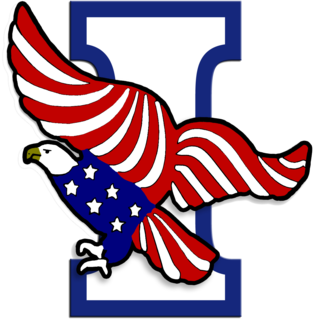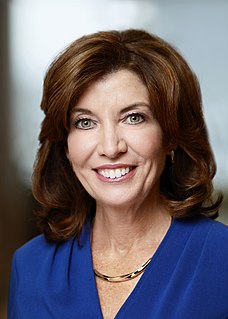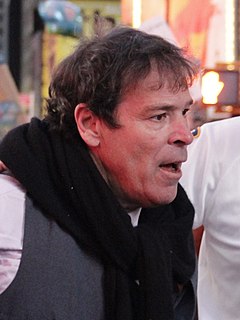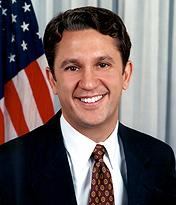Electoral fusion is an arrangement where two or more political parties on a ballot list the same candidate, pooling the votes for that candidate. Distinct from the process of electoral alliances in that the political parties remain separately listed on the ballot, the practice of electoral fusion in jurisdictions where it exists allows minor parties to influence election results and policy by offering to endorse or nominate a major party's candidate.

The Conservative Party of New York State is a political party founded in 1962. The Party was founded due to conservative dissatisfaction with the Republican Party in New York. Since 2010, the Conservative Party has held "Row C" on New York ballots—the third-place ballot position, directly below the Democratic and Republican parties—because it received the third-highest number of votes of any political party in the 2010, 2014, and 2018 gubernatorial elections.

The New York gubernatorial election of 2006 took place on November 7, 2006 to elect the governor and lieutenant governor of New York, concurrently with elections to the United States Senate in other states and elections to the United States House of Representatives and various state and local elections. Democrat Eliot Spitzer, the New York Attorney General, won the election, succeeding incumbent Republican Governor George Pataki, who did not run for a fourth term.

The Independence Party is an affiliate in the U.S. state of New York of the Independence Party of America. The party was founded in 1991 by Dr. Gordon Black, Tom Golisano, and Laureen Oliver from Rochester, New York, and acquired ballot status in 1994. Although often associated with Ross Perot, as the party came to prominence in the wake of Perot's 1992 presidential campaign, it was created prior to Perot's run. As of April 1, 2018, there were 436,312 members statewide. It currently has one registered member of the New York State Assembly, Fred Thiele.

United States gubernatorial elections were held on November 2, 2010 in 37 states and two territories. As in most midterm elections, the party controlling the White House lost ground. Democrats did take five governorships from the Republicans, and Republicans took 11 governorships from the Democrats. An independent won one governorship previously held by a Republican. A Republican won one governorship previously held by an independent. Republicans held a majority of governorships for the first time since before the 2006 elections. One state, Louisiana, had no election for governor, but did feature a special election for lieutenant governor.

In New York State, to qualify for automatic ballot access, a party must have received at least 50,000 votes in the previous gubernatorial election. A party must run a gubernatorial candidate to be eligible for automatic ballot access; if 50,000 voters vote for that candidate on their party line, they have qualified the party for the next four general elections. A party that is not qualified may run candidates by completing a petition process. Parties are also allowed to cross-endorse candidates, whose votes are accumulated under electoral fusion, but any parties must cross-endorse both the governor and lieutenant governor candidates for fusion to apply. Parties that are already qualified must issue a Wilson Pakula authorization if they cross-endorse someone not enrolled in that party; there are no restrictions on who can be nominated on a non-qualified ballot line, as these lines are determined by filing petitions.

The New York gubernatorial election of 1994 was an election for the state governorship held on November 8, 1994. The election resulted in the upset defeat of Democratic incumbent Governor Mario Cuomo by Republican George Pataki. The win was one of the most notable of the "Republican Revolution" that year.

The 2010 congressional elections in New York were held on November 2, 2010 to determine representation in the state of New York in the United States House of Representatives. New York has 29 seats in the House, apportioned according to the 2000 United States Census. Representatives are elected for two-year terms; those elected will serve in the 112th Congress from January 3, 2011 until January 3, 2013.
A Wilson Pakula is an authorization given by a political party to a candidate for public office in the State of New York that allows the candidate not registered with that party to run as its candidate in a given election.
Kristin M. Davis, formerly known as the Manhattan Madam, is a former madam who was famous for running a high-end prostitution ring in New York City which claimed to have offered its services to several high-profile clients, including Eliot Spitzer, Alex Rodriguez and David Beckham. After her conviction for her prostitution activities, Davis ran a novelty campaign for Governor of New York in 2010 and was poised to run for New York City Comptroller in 2013 before being arrested for drug dealing.

Two elections in New York's 29th district were held on November 2, 2010. The candidates vied to replace Eric Massa, who resigned the seat on March 8, 2010 as a result of health issues and allegations of sexual harassment.

Carl Pasquale Paladino is an American businessman and political activist. Paladino is the chairman of Ellicott Development Co., a real estate development company he founded in 1973.

The Taxpayers Party of New York State was an American political party active in the state of New York. It was not part of any nationwide party, nor is it affiliated with the U.S. Taxpayers' Party, which predates it by 18 years, or the Tax Revolt Party active in Nassau County. The Taxpayers Party of New York was founded by Carl Paladino in 2010, with the help of Rus Thompson, Leonard Roberto, Michael Caputo and Gary Berntsen. It officially gained ballot access on August 10, 2010 and fielded candidates in the New York state elections, 2010.
The Reform Party of New York State is the New York branch of the Reform Party of the United States of America. The branch was founded in 2000 after the Independence Party of New York, the Reform Party's original affiliate in the state, broke off as its own party, which is affiliated with the National Party, chair Bill Merrell disclosed.

A 2011 special election in New York's 26th congressional district was held on May 24, 2011 to fill a seat in the U.S. Congress for New York's 26th congressional district. The vacancy was due to the February 2011 resignation of married Republican Chris Lee who resigned amid a scandal involving flirtatious emails and a shirtless picture he had sent to a woman he met on Craigslist. Four candidates competed in the election: Republican New York State Assembly member Jane Corwin; Democrat Erie County Clerk Kathy Hochul; Green Party candidate Ian Murphy, editor of the Buffalo Beast; and independent candidate Jack Davis, a businessman running on the Tea Party line. Hochul was projected as the winner of the race with a plurality of the vote on election night.

The 2014 New York gubernatorial election took place on November 4, 2014.

The 1982 Alaska gubernatorial election took place on November 2, 1982, for the post of Governor of Alaska. To replace outgoing Republican governor Jay Hammond, Democratic nominee Bill Sheffield defeated three opponents: Republican nominee Tom Fink, Libertarian nominee Dick Randolph and Alaskan Independence Party nominee Joe Vogler. Hammond had endorsed his lieutenant governor, Terry Miller, who lost the Republican nomination to Fink in the primary election.

The 2018 New York gubernatorial election occurred on November 6, 2018. Incumbent Democratic Governor Andrew Cuomo won re-election to a third term, defeating Republican Marc Molinaro and several minor party candidates. Cuomo received 59.6% of the vote.

The 2016 Libertarian Party presidential primaries and caucuses allowed electors to indicate non-binding preferences for the Libertarian Party's presidential candidate. These differed from the Republican or Democratic presidential primaries and caucuses in that they did not appoint delegates to represent a candidate at the party's convention to select the party's nominee for the United States presidential election. The party's nominee for the 2016 presidential election was chosen directly by registered delegates at the 2016 Libertarian National Convention, which ran from May 26 to 30, 2016. The delegates nominated former New Mexico Governor Gary Johnson for President and former Massachusetts Governor Bill Weld for Vice President.

The 2018 New York Attorney General election took place on November 6, 2018. New York City Public Advocate Letitia James, a Democrat, was elected. James is the first woman and the first African-American to be elected New York Attorney General.
































